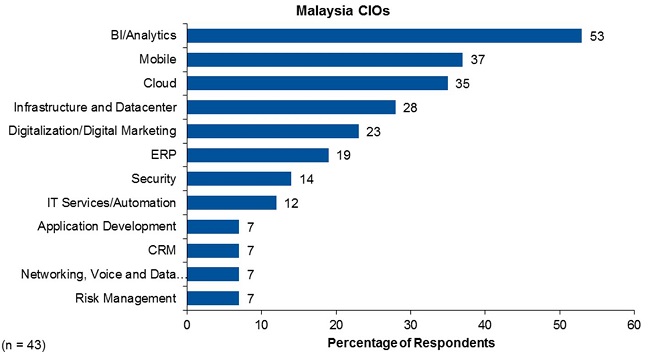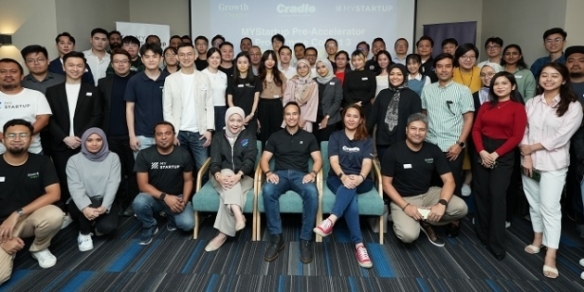No excuses: Malaysian CIOs have an edge, says Gartner
By Digital News Asia May 5, 2016
- 69% of Malaysian CIOs expect internal IT budgets to grow in 2016
- South-East Asia CIOs expect to see digital revenue grow from 15% to 38%

MALAYSIAN CIOs (chief information officers) face more favourable conditions than many of their peers when it comes to establishing themselves as digital leaders, according to Gartner Inc’s 2016 CIO Agenda survey.
While the survey found that global IT budgets are fairly static compared to 2015, with an average growth of just over 2%, Malaysia shows an average change in total IT budgets of 8%.
Furthermore, compared to their global peers, Malaysian CIOs have more control over their enterprise's IT investments and can leverage this to strengthen their position as digital influencers, the research and analyst firm said in a statement.
READ ALSO: IT managers need to step up and drive the business: Pikom
Gartner’s 2016 CIO Agenda survey asked 2,944 CIOs worldwide about their top digital business opportunities, threats and strategies, with responses from 103 CIOs in South-East Asia including 43 from Malaysia.
Data from the 2016 survey shows that globally, the average CIO is expecting digital revenue to grow from 16% to 37% in the next five years.
 In South-East Asia, CIOs expect to see digital revenue grow from 15% to 38% in the same period, indicating that they are poised to make the most of digital business opportunities.
In South-East Asia, CIOs expect to see digital revenue grow from 15% to 38% in the same period, indicating that they are poised to make the most of digital business opportunities.
“Malaysian CIOs are seeing their IT budgets increase, they are leading in digital initiatives and innovation, and there is a growing recognition from Malaysian businesses of the importance of digitalisation for competitive advantage,” Gartner research director Bard Papegaaij (pic).
“This doesn’t mean CIOs in Malaysia can just wait for things to go their way.
“They face a looming skills shortage, they need to keep working on growing their influence and power and they must take the lead in shaping the best possible circumstances for their enterprises to thrive as digital businesses,” he added.
Spending priorities
The survey revealed the top areas of new technology spending in Malaysia to be on business intelligence/ analytics, mobile and cloud (see figure below).
With 35% cloud spending compared with a global percentage of 25%, it seems that Malaysian CIOs are leading the way in freeing up budgets and creating the flexibility for a more digital focus by reducing their investment in internal infrastructure and data centres.
“The need to innovate is driving penetration and deepening of the bimodal construct, where two separate, coherent modes of IT delivery are managed – one focused on stability and the other on agility,” said Gartner vice president and executive partner Lee Poh-Ling.
“With a larger increase of IT spending under their control than most of their global peers, Malaysian CIOs have more room to invest in setting up and developing bimodal capabilities.
“By using the extra room in their IT budgets this way, they can help their organisations reap the benefits of digitalisation sooner than the competition,” she added.

Q: Please indicate the top three technology areas where your organisation will be spending the highest amount of new/discretionary funding in 2015.
Demand for talent
While Malaysian respondents in the survey said that mobile, digitalisation/ digital marketing and BI/ analytics are the most important technology areas to help their business differentiate, win and achieve its mission, skills and talent in these areas are in huge demand globally.
“CIOs everywhere state that talent is the single biggest issue standing in their way of achieving their objectives,” said Lee.
“The bottom line, however, is that CIOs and their enterprises aren't acting fast enough. The talent pool and talent management practices are not keeping up with the ever-increasing and changing needs of the digital world,” she added.
Lee said that instead of thinking of talent as a strictly internal asset, CIOs must think about talent as a platform with semi-porous boundaries, where internal and external talent meet and collaborate and multiply their potential.
Strategies may include rotating staff from outside the IT organisation, working much more closely with universities, crowdsourcing and considering customers, citizens, vendors and partners as extensions of the talent platform.
Especially for Malaysian CIOs who are seeing their internal IT budgets grow more than that of their global peers, the rising trend of ‘techquisitions’ – buying promising startups to obtain both their technology and their talent – is something to consider.
However, this strategy on its own is unlikely to be enough if the other barriers to success are not addressed in parallel, Gartner said.
Leadership and culture

Great talent thrives only in a supportive culture and needs the right organisational structures, change-readiness and strong sponsorship from and relations with the business to be able to innovate and operate effectively, the analyst firm said.
Just hiring or acquiring the best talent without creating the right environment will lead to newly brought-in stars quickly sinking into the background or leaving as soon as they see an opportunity, it added.
“CIOs are being given, and they are taking, the opportunity to lead digital transformation, but they must adapt to build a powerful network of digital leadership, which is, after all, a team sport,” said Papegaaij.
“One thing that has not and will not change is that leadership is critical for all business success. IT and digital business are no different in that respect.
“Having strong and clear leadership as the IT and digital business worlds evolve continues to be critical,” he added.
In South-East Asia, 41% of CIOs believe that they are stepping up and taking the digital transformation leadership role, while a further 41% say they are taking on innovation leadership – both numbers are slightly higher than the global percentage (39% and 34% respectively).
An area of concern for Malaysian CIOs, however, is their power and influence in the organisation.
Compared with their global peers, Malaysian CIOs report that 50% of them are in a partnering position with the CEO (chief executive officer) – on par with the global percentage – but only 13% have moved beyond partnering to become trusted allies (compared with 23% globally).
A good 38% are still in the relative danger zone of the transactional relationship with the CEO (only 25% globally).
“Transactional CIOs need to spend more time and energy moving away from this position, and to use digital opportunities to show their business peers that IT can and must be much more proactive and strategically involved than just taking orders or keeping the lights on,” said Papegaaij.
“CIOs that have a partnering position must not stop there, but focus even more on showing true leadership and spend more time building close relationships with their peers in the C-suite,” he added.
Related Stories:
Saving the CIO, Part 1: Aligning business needs, fighting bureaucracy
Saving the CIO, Part 2: Finding talents, changing mind-sets
Bad times the best time for digital transformation: Gartner
CIOs making their presence felt in the boardroom: BT study
For more technology news and the latest updates, follow us on Twitter, LinkedIn or Like us on Facebook.


